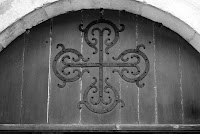
Two weeks after Hurricane Katrina hit, I drove from Baton Rouge to New Orleans to experience firsthand the devastation of a place that I love dearly. I thought I had prepared myself for what I would see, but, indeed, I had not.
Approaching the city, I saw coffins that had floated out of the large above ground cement mausoleums and found a new resting place alongside the interstate. I wept. Not only had the living been affected by the flood waters, but also the dead.
Going further, I witnessed the large gaping hole in the roof of the Superdome and instantly returned to the images of the thousands who took refuge in this shelter of last resort-turned prison. Large blue tarps covered many homes and served as temporary roofs, a thin blue layer between fragile people and the wild nature that had so recently turned against them.
I parked my car in the normally bustling French Quarter, though this time, it was a ghost town. Peeking into Pat O’Brien’s famous bar, which usually hosts raucous dueling pianos, I was struck this time by the emptiness and hollow silence in its stead. The windy breezes stirred up alternating wisps of rotting food and mold. Fresh graffiti screamed anger towards President Bush, FEMA, and Governor Blanco. When I encountered people in the streets (which was rare), they were lifeless and listless: walking zombies who had their life sucked out of them.
There seemed to be so much despair, sadness, and loss of hope. Where was the light that shines in the darkness? Where was God in all of this mess?
In the many years before Katrina, I travelled to New Orleans on Sunday afternoons to gather with friends at the corner of St. Ann and Bourbon Street for what is known in the gay community as “Sunday Tea Dance”. This was sacred ground for me, a ground zero of sorts from which I “came out” as a gay man. Through the years, I had danced many nights away at the Tea Dance, laughing, singing, sharing stories, meeting new people, sometimes drinking too much and having a little too much fun. But the Tea Dance was where people knew to gather on Sunday afternoon.
My favorite stop at the Tea Dance was the Good Friend’s Bar, where a gentleman named Tom played an old piano on the second floor of the bar that sounded as if it came from a old western movie saloon. Tom was in his late sixties and gathered an eclectic group of people--gay, straight, men, women--around that old, out of key piano for a weekly sing along. We enjoyed singing show tunes, but sometimes when I would arrive, Tom would play a Gospel Set of well known Southern hymns and ballads. People would sing loudly. Many of them loved the church, but they no longer attended because they had either been either kicked out or left due to its stand on their “gay lifestyle”.
As I walked around a desolated New Orleans that fall afternoon, I wondered if any of my kindred were gathering at that sacred corner where we had spent so many Sundays at the Tea Dance. I turned onto Bourbon Street and glanced down at the section of the French Quarter where my father used to warn me, “Do not go down there son, it is where the homosexuals gather.” To my joy and delight, I saw life! In the distance, I heard the thumps of the deejay as I made out the gay anthem “We are Family” in my head. A few steps closer. Over 100 people were standing around the Bourbon Pub/Parade Disco, which reopened that day, peace and happiness swept over me. The community indeed knew where to gather that afternoon, even in the midst of desolation and despair.
A giant blue tarp covered the roof of the Good Friend’s Bar...surely, the second floor was flooded in the deluge, I supposed. But then, in the distance, I noticed the faint sound of singing. Could it be? Was Tom there? Were the faithful gathered around the piano? Drawing closer and closer to Good Friend’s, the singing was louder and louder. I walked into group of 30 people who were indeed standing around the piano, having picked it up and carried it downstairs so that they could sing.
Tom looked up, saw me, and yelled, “PADRE, YOU ARE HERE” and he began to play Gospel music and people assembled sang out from their hearts! First was “I Come to the Garden Alone”, and then a stirring rendition of “His Eye is on the Sparrow”. The voices grew louder and heartier. People raised the rafters in joy and celebration as tears filled our eyes. For the wayward souls assembled that day, even in the midst of destruction and despair, this was Church! We were not in a building consecrated by a bishop. The space was not filled with stained glass and statues. Instead, we were a church formed from the presence of the people and our piano became our altar, a place of sacrifice where we could offer to God our tears, our joys, our prayers, and our hopes. The piano became a sign and symbol of God’s redemption and love in our midst.






































